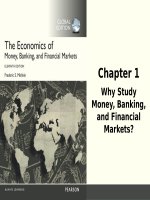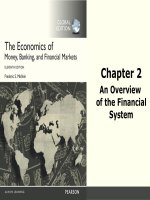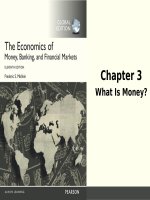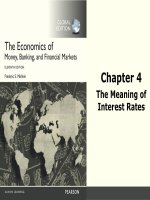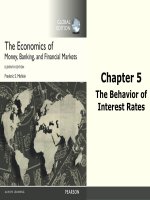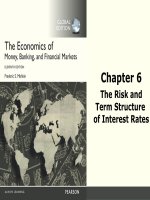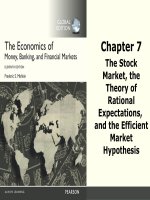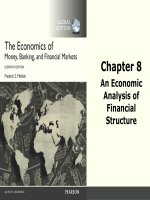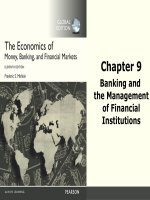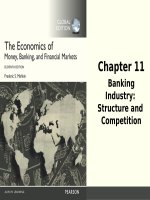The economics of money, banking, and financial institutions 2nd ch13
Bạn đang xem bản rút gọn của tài liệu. Xem và tải ngay bản đầy đủ của tài liệu tại đây (779.96 KB, 37 trang )
Chapter 13
Financial Derivatives
© 2005 Pearson Education Canada Inc.
Hedging
Hedge: engage in a financial transaction that reduces or
eliminates risk
Basic hedging principle:
Hedging risk involves engaging in a financial
transaction that offsets a long position by taking a short
position, or offsets a short position by taking a
additional long position
© 2005 Pearson Education
13-2
Buying and Writing Calls
• A call option is an option that gives the owner the right (but
not the obligation) to buy an asset at a pre specified exercise
(or striking) price within a specified period of time.
• Since a call represents an option to buy, the purchase of a call
is undertaken if the price of the underlying asset is expected to
go up.
• The buyer of a call is said to be long in a call and the writer is
said to be short in a call.
• The buyer of a call will have to pay a premium (called call
premium) in order to get the writer to sign the contract and
assume the risk.
© 2005 Pearson Education
13-3
The Payoff from Buying a Call
To understand calls, let's assume that you hold a European call
on an asset with an exercise price of X and a call premium of α.
• If at the expiration date, the price of the underlying asset, S, is
less than X, the call will not be exercised, resulting in a loss of
the premium.
• At a price above X, the call will be exercised. In particular, at a
price between X and X + α, the gain would be insufficient to
cover the cost of the premium, while at a price above X + α the
call will yield a net profit.
• In fact, at a price above X + α, each $1 rise in the price of the
asset will cause the profit of the call option to increase by $1.
© 2005 Pearson Education
13-4
The Payoff from Writing a Call
The payoff function from writing the call option is the mirror
image of the payoff function from buying the call.
Note that the writer of the call receives the call premium, α, up
front and must stand ready to sell the underlying asset to the
buyer of the call at the exercise price, X, if the buyer exercises
the option to buy.
© 2005 Pearson Education
13-5
Summary and Generalization
In general, the value of a call option, C, at expiration with asset
price S (at that time) and exercise price X is
C = max (0, S - X)
In other words, the value of a call option at maturity is S - X, or
zero, whichever is greater.
• If S > X, the call is said to be in the money, and the owner will
exercise it for a net profit of C - α.
• If S < X, the call is said to be out of the money and will expire
worthless.
• A call with S = X is said to be at the money (or trading at par).
© 2005 Pearson Education
13-6
Buying and Writing Puts
A second type of option contract is the put option. It gives the
owner the right (but not the obligation) to sell an asset to the
option writer at a pre specified exercise price.
• As a put represents an option to sell rather than buy, it is worth
buying a put when the price of the underlying asset is expected
to fall.
• As with calls, the owner of a put is said to be long in a put and
the writer of a put is said to be short in a put.
• Also, as with calls, the buyer of a put option will have to pay a
premium (called the put premium) in order to get the writer to
sign the contract and assume the risk.
© 2005 Pearson Education
13-7
The Payoff from Buying a Put
Consider a put with an exercise price of X and a premium of β.
• At a price of X or higher, the put will not be exercised,
resulting in a loss of the premium.
• At a price below X - β, the put will yield a net profit.
• In fact, between X - β and X, the put will be exercised, but the
gain is insufficient to cover the cost of the premium.
© 2005 Pearson Education
13-8
The Payoff from Writing a Put
The payoff function from writing a put is the mirror image of
that from buying a put.
As with writing a call, the writer of a put receives the put
premium, β, up front and must sell the asset underlying the
option if the buyer of the put exercises the option to sell.
© 2005 Pearson Education
13-9
Summary and Generalization
In general, the value of a put option, P, at the expiration date
with exercise price X and asset price S (at that time) is
P = max (X - S, 0)
That is, the value of a put at maturity is the difference between
the exercise price of the option and the price of the asset
underlying the option, X - S, or zero, whichever is greater.
• If S > X, the put is said to be out of the money and will expire
worthless.
• If S < X, the put is said to be in the money and the owner
will exercise it for a net profit of P - β.
• If S = X, the put is said to be at the money.
© 2005 Pearson Education
13-10
Factors Affecting Premium
1.
Higher strike price ⇒ lower premium on call options
and higher premium on put options
2.
Greater term to expiration ⇒ higher premiums for
both call and put options
3.
Greater price volatility of underlying instrument ⇒
higher premiums for both call and put options
© 2005 Pearson Education
13-11
Spot, Forward, and Futures
Contracts
• A spot contract is an agreement (at time 0) when the seller
agrees to deliver an asset and the buyer agrees to pay for the
asset immediately (now)
• A forward contract is an agreement (at time 0) between a
buyer and a seller that an asset will be exchanged for cash at
some later date at a price agreed upon now
• A futures contract is similar to a forward contract and is
normally arranged through an organized exchange (i.e., ME,
CBT)
The main difference between a futures and a forward contract
is that the price of a forward contract is fixed over the life of
the contract, whereas futures contracts are marked-to-market
daily.
© 2005 Pearson Education
13-12
Financial Futures Markets
Financial futures are classified as
• Interest-rate futures
• Stock index futures, and
• Currency futures
In Canada, financial futures are traded in
the Montreal Exchange (see Table 13-1)
© 2005 Pearson Education
13-13
Interest-Rate Forward Markets
Long position = agree to buy securities at future date
Hedges by locking in future interest rate if funds coming in future
Short position = agree to sell securities at future date
Hedges by reducing price risk from change in interest rates if
holding bonds
Pros
1. Flexible (can be used to hedge completely the interest rate risk)
Cons
1. Lack of liquidity: hard to find a counterparty to make a
contract with
2. Subject to default risk: requires information to screen good
from bad risk
© 2005 Pearson Education
13-14
Widely Traded Interest-Rate
Futures Contracts
© 2005 Pearson Education
13-15
Interest Rate Futures Markets
Interest Rate Futures Contract
1. Specifies delivery of type of security at future date
2. Arbitrage ⇒ at expiration date, price of contract = price of the
underlying asset delivered
3. i ↑, long contract has loss, short contract has profit
4. Hedging similar to forwards
Micro vs. macro hedge
Traded on Exchanges: Global competition
Success of Futures Over Forwards
1. Futures more liquid: standardized, can be traded again, delivery
of range of securities
2. Delivery of range of securities prevents corner
3. Mark to market: avoids default risk
4. Don’t have to deliver: netting
© 2005 Pearson Education
13-16
Widely Traded Stock Index Futures
Contracts
© 2005 Pearson Education
13-17
Widely Traded Currency Futures
© 2005 Pearson Education
13-18
Profits and Losses: Options vs. Futures
$100,000 Canada-bond contract,
1. Exercise price of 115,
$115,000.
2. Premium = $2,000
© 2005 Pearson Education Canada Inc.
13-19
Payoff Function from Buying an
Interest Rate Futures (see Fig. 13-1)
Consider the June Canada bond futures contract traded on the
ME. If you buy this contract for 115, you agree to pay $115,000
for $100,000 face value of long-term Canadas when they are
delivered to you at the end of June. If at the expiration date the
underlying Canada bond for the futures contract has a price of
• 110, meaning that the price of the futures contract also falls to
110, you suffer a loss of 5 points, or $5,000 (point A')
• 115, you would have a zero profit (point B')
• 120, you would have a profit on the contract of 5 points, or
$5,000 (point C')
© 2005 Pearson Education
13-20
Payoff Function from Selling an
Interest Rate Futures (see Fig. 13-1)
If you sell this contract for 115, you agree to deliver
$100,000 face value of long-term Canada bonds for $115,000
at the end of June. If at the expiration date the underlying
Canada bond for the futures contract has a price of
• 110, meaning that the price of the futures contract also falls
to 110, you gain 5 points, or $5,000 (point A')
• 115, you would have a zero profit (point B')
• 120, you would have a loss on the contract of 5 points, or
$5,000 (point C')
© 2005 Pearson Education
13-21
Figure 13-1.
Interest Rate Futures Options
An option contract on the ME's June Canada bond futures
contract has the following key features:
• it has the same expiration date as the underlying futures
contract
• it is an American option and so can be exercised at any time
before the expiration date, and
• the premium of the option is quoted in points that are the same
as in the futures contract, so each point corresponds to $1,000.
© 2005 Pearson Education
13-22
How Interest Rate Futures Options
Work (see Fig. 13-1)
Suppose that today you buy, for a $2,000 premium, a European call
on the $100,000 June Canada bond futures contract with a strike
price of 115. If at the expiration date the underlying Canada bond
for the futures contract has a price of
• 110, the futures call will be out of the money, since S
• 115, the futures call will be at the money, but produces no gain or
loss (point B)
• 120, the futures call will be in the money and will be exercised. You
would buy the futures contract at the exercise price of 115 and then
sell it for 120, thereby earning a 5-point gain ($5,000 profit) on the
$100,000 Canada bond contract. Because you paid a $2,000
premium, however, the net profit is $3,000 (point C)
© 2005 Pearson Education
13-23
Figure 13-1. The Difference between
Interest Rate Futures and Interest Rate
Futures
• the futuresOptions
contract has a linear profit function --- there is a oneto-one relationship between profits and the price of the underlying
financial instrument
• the kinked profit curve for the option contract is nonlinear,
meaning that profits don't always grow by the same amount for a
given change in the price of the underlying financial instrument
• the reason for this nonlinearity is that the call option protects you
from having losses that are greater than the amount of the $2,000
premium
• once the price of the underlying financial instrument rises above X,
however, your profits on the call option grow linearly. They are,
however, always less than the profits on the futures contract by
exactly the $2,000 premium paid.
© 2005 Pearson Education
13-24
Currency Futures
Hedging FX Risk
Example: Customer due € 20 million in two months,
current € = $0.50
1. Forward agreeing to sell € 20 million for $10
million, two months in future
2. Sell € 20 million of futures
© 2005 Pearson Education
13-25
